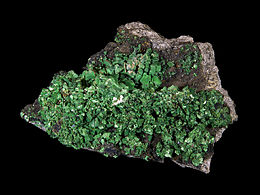Torbernite
This article needs additional citations for verification. (September 2018) |
| Torbernite | |
|---|---|
 | |
| General | |
| Category | Phosphate minerals |
| Formula (repeating unit) | Cu(UO2)2(PO4)2 · 8-12 H2O (hydrated copper uranyl phosphate) |
| Strunz classification | 8.EB.05 |
| Crystal system | Tetragonal |
| Crystal class | Ditetragonal dipyramidal (4/mmm) H-M symbol: (4/m 2/m 2/m) |
| Space group | I4/mmm |
| Identification | |
| Formula mass | 641 – 713 g/mol, depending the degree of water loss |
| Color | Emerald green to apple green |
| Crystal habit | Tabular crystals; Foliated to earthy masses and encrustations |
| Twinning | Rare on [110] |
| Cleavage | [001] Perfect; [100] Distinct |
| Fracture | Brittle |
| Mohs scale hardness | 2 - 2.5 |
| Luster | Vitreous; Pearly |
| Streak | Pale green |
| Diaphaneity | Transparent to subtranslucent |
| Specific gravity | 3.2 |
| Optical properties | Uniaxial (-) |
| Refractive index | nω = 1.590 - 1.592 nε = 1.581 - 1.582 |
| Birefringence | δ = 0.009 - 0.010 |
| Pleochroism | Visible |
| Melting point | Decompose before |
| Fusibility | Decompose before |
| Other characteristics | |
| References | [1][2] |
Torbernite, whose name derives from the Swedish chemist Torbern Bergman (1735–1784),[3] is a radioactive, hydrated green copper uranyl phosphate mineral, found in granites and other uranium-bearing deposits as a secondary mineral. Torbernite is isostructural with the related uranium mineral, autunite.[4]
The chemical formula of torbernite is similar to that of autunite in which a Cu2+ cation replaces a Ca2+. The number of water hydration molecules can vary between 12 and 8, giving rise to the variety of metatorbernite when torbernite spontaneously dehydrates. Their respective chemical compositions are the following:
- Torbernite
- Cu(UO2)2(PO4)2 · 12 H2O
- Metatorbernite
- Cu(UO2)2(PO4)2 · 8 H2O
Torbernite's most common alternative names are copper uranite and cupro-uranite.
Uses[]
As a radioactive mineral, torbernite has some limited significance as a uranium ore. Its vibrant green color and well-developed distinctive crystals (size: mm to a few cm) make it a sought-after collector's mineral, as well.[5] However, torbernite, like other hydrated minerals, can easily suffer from loss of water molecules. This loss of water from the mineral leads to an alteration of torbernite specimens into its pseudomorph, meta-torbernite. Some collector's websites assert that any torbernite specimen more than a few years old should be considered fully transitioned to meta-torbernite. However, it likely depends on the temperature and relative humidity of ambient air in which specimens are stored.
As torbernite is radioactive and outgases radon (222Rn), collectors are urged to take proper precautions in the handling and storage of any specimens.[6] An adequate ventilation of the rooms and the cabinets in which the specimens are stored is essential to evacuate the radioactive radon gas responsible for lung cancer,[7] but it could increase the dehydration rate of the specimens. To limit radon inhalation, naked specimens should never be stored in rooms in which one spends much living or working time. An alternative is to store specimens in gas tight transparent containers in which radon will accumulate and decay to secular equilibrium.
Associated minerals[]
Torbernite frequently occurs in conjunction with other uranium minerals, as well as host rock minerals. These associated minerals include:
- autunite, Ca(UO2)2(PO4)2 · 8-12 H2O
- uraninite, UO2
- uranophane, Ca(UO2)2Si2O7 · 6 H2O
- uranocircite, Ba(UO2)2(PO4)2 · 8-12 H2O
- topaz, Al2SiO4(F,OH)2
Identification[]
The most obvious factor in identifying torbernite is its radioactivity. However, since it is frequently found in association with other radioactive minerals, this may not be useful in separating one uranium mineral from the rest. A next step would be to check color. Most uranium-bearing minerals are bright yellow or green. As torbernite is exclusively green, this can be a useful secondary fact.[8] Crystal habit is also useful, but as it shares a similar structure and color with autunite. Nonetheless, regardless of identification, it is likely that at least some of the specimen will have already altered to meta-torbernite.
See also[]
References[]
- ^ http://webmineral.com/data/Torbernite.shtml Webmineral
- ^ http://www.mindat.org/min-3997.html Mindat
- ^ "Torbernite". www.mindat.org. Retrieved 2021-05-04.
- ^ "Torbernite | mineral". Encyclopædia Britannica. Retrieved 2021-05-04.
- ^ "Torbernite". www.usgs.gov. Retrieved 2021-05-04.
- ^ "Radioactivity: Mineral Properties - the Mineral and Gemstone Kingdom".
- ^ Nace, Trevor. "9 Deadliest Rocks And Minerals On Earth". Forbes. Retrieved 2021-05-04.
- ^ "Top Radioactive Minerals: Occurrence and Identification". Retrieved 2021-05-04.
External links[]
 Media related to Torbernite at Wikimedia Commons
Media related to Torbernite at Wikimedia Commons
- Copper(II) minerals
- Uranium(VI) minerals
- Phosphate minerals
- Radioactive minerals
- Tetragonal minerals
- Minerals in space group 139